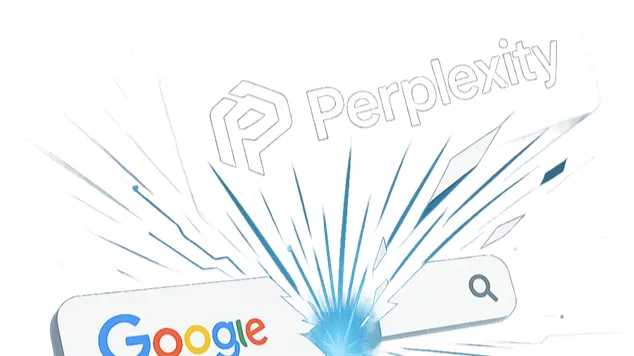The Knowledge Singularity
How Perplexity Challenges Google's Dominance
The history of technological disruption often follows a predictable pattern, yet each iteration brings unprecedented transformation. As humanity witnessed its first Singularity moment for Knowledge through the internet era, Google emerged from the shadows to fundamentally reshape how we access information. Today, we stand at the precipice of another Singularity moment—this time in the AI Epoch—and Perplexity AI is executing the Innovator's Solution to Google's Innovator's Dilemma with remarkable precision and audacity.[1][2]
The Dawn of Democratized Knowledge Access
The late 1990s and early 2000s marked humanity's first encounter with democratized knowledge access. The internet had created unprecedented content availability, yet the challenge lay in organizing and accessing this vast repository of information. This period represents what futurists now recognize as the Knowledge Singularity—a moment when information became abundantly available but required new paradigms for navigation and comprehension.[3][4][5][6]
Image Credit: Vintage Yahoo! homepage interface from the 1990s - Public Domain via Wikimedia Commons

Vintage Yahoo! UK homepage displayed on a pixelated computer screen from the 1990s internet era.
📊 The Knowledge Explosion
Yahoo, the early internet pioneer, dominated with a directory-based approach, manually categorizing websites in a hierarchical structure. This method worked when the web was smaller, but as content exploded exponentially, Yahoo's model became increasingly inadequate. The company's curated approach couldn't scale with the internet's organic growth, creating the perfect conditions for disruption.[7][8][9]
Google's Masterstroke: The PageRank Revolution
Google sensed the opportunity in this abundant content landscape and recognized the fundamental flaw in existing approaches. While Yahoo treated search as a utility, Google understood that search was the gateway to the internet itself. The company's founders, Larry Page and Sergey Brin, developed the revolutionary PageRank algorithm that ranked websites based on the quality and quantity of links pointing to them—essentially creating a democratic voting system where websites vouched for each other's credibility.[7][8][10]

Aerial view of Google's Mountain View headquarters with solar panels visible on the buildings' roofs.
Image Credit: Google Googleplex headquarters in Mountain View, California - Licensed under Creative Commons
🎯 Google's Innovation Advantage
This innovation perfectly embodied Clayton Christensen's Innovator's Dilemma framework. Yahoo, despite having multiple opportunities to acquire Google (first for $1 million in 1998, then for $3 billion in 2002), dismissed the startup's potential. Yahoo's leadership was constrained by their existing business model and couldn't envision how search would become the internet's primary interface.[8][11][12][13]
Meanwhile, Google was free to innovate without the burden of protecting legacy revenue streams. The company's continuous innovation philosophy became their competitive moat. While Yahoo stagnated with outdated technology, Google relentlessly improved search quality, introduced AdWords for monetization, and expanded into complementary services like Gmail, Google Maps, and Google Drive.[7][14][8]
The Innovator's Dilemma Unfolds
The Google-Yahoo transition offers crucial insights for understanding technological disruption patterns:
Timing Recognition: Google succeeded not just because of superior technology, but because they recognized the right moment when internet content had reached sufficient scale to require algorithmic organization.[7][8]
Business Model Innovation: Google's AdWords created a sustainable revenue model aligned with user behavior, while Yahoo's advertising was disconnected from search functionality.[8][14]
Ecosystem Development: Google built complementary services that reinforced their search dominance, creating switching costs and network effects.[7][8]
Long-term Vision: Google invested heavily in R&D and infrastructure while Yahoo focused on short-term revenue optimization.[14][8]
⚡ The Disruption Timeline
Each new service created network effects that strengthened Google's ecosystem and made user switching increasingly difficult. By 2010, Google had achieved what seemed like an insurmountable 87.57% global search market share, generating hundreds of billions in revenue and becoming synonymous with internet search itself.[15][16][17]
The AI Singularity Emerges: Enter Perplexity
Fast-forward to 2024, and we're witnessing history repeat itself with remarkable clarity. Google now occupies the position Yahoo held two decades ago—a dominant incumbent with massive market share but facing the constraints of protecting a $198 billion annual search revenue stream. The emergence of artificial intelligence has created another Singularity moment, this time in the realm of intelligence itself.[3][5][6][18]
Enter Perplexity AI, founded in August 2022 by Aravind Srinivas and his co-founders, with a radically different approach to information access. The company represents the latest evolution in the democratization of knowledge, moving beyond simple information retrieval to intelligent synthesis and analysis.[1][19][20][21]
🚀 Perplexity's Rapid Ascent
Perplexity's Innovator's Solution addresses Google's core dilemma: how to innovate without cannibalizing existing revenue. While Google must carefully balance AI integration to avoid disrupting its advertising-dependent search results, Perplexity built its platform around AI-first principles from day one.[18][20]
The strategic brilliance of Perplexity's approach lies in starting with niche use cases that Google's current model serves poorly. Traditional search engines excel at finding specific websites or products, but they struggle with complex research questions requiring synthesis from multiple sources. Perplexity's Answer Engine directly addresses these pain points by providing comprehensive, cited responses rather than lists of links.[1][20]
The Technology Behind the Revolution
Perplexity's technological foundation represents a fundamental paradigm shift. Unlike traditional search engines that index and retrieve web pages, Perplexity employs Large Language Models (LLMs) to understand, analyze, and synthesize information from multiple sources simultaneously. This approach transforms search from a retrieval task into an intelligence amplification process.[20][21]
The company's architecture combines several breakthrough technologies:
Advanced Natural Language Processing: Understanding complex, conversational queries rather than keyword matching.[21][20]
Real-time Web Crawling: Accessing fresh information from across the internet rather than relying on pre-indexed content.[1][20]
Source Attribution: Providing citations and links to original sources, maintaining transparency and credibility.[1][20]
Contextual Understanding: Maintaining conversation context across multiple follow-up questions.[20][21]
🔧 Technical Innovation
AI-Powered Search (Perplexity):
This technological foundation enables Perplexity to address use cases where traditional search fails. Research tasks that previously required visiting dozens of websites, comparing information, and synthesizing insights can now be completed through a single conversational interface.[21][20]
Market Dynamics and User Adoption
The market's response to Perplexity demonstrates the pent-up demand for more intelligent information access. Despite Google's seemingly insurmountable market position, Perplexity has achieved remarkable traction in just 24 months.[18][19]
Several factors contribute to this rapid adoption:
Generational Shift: Younger users, accustomed to conversational AI interfaces, find Perplexity's approach more intuitive than traditional search.[15][22]
Professional Use Cases: Researchers, analysts, and knowledge workers increasingly rely on Perplexity for complex information synthesis tasks.[19][18]
Quality Differentiation: Users report higher satisfaction with Perplexity's comprehensive, cited responses compared to Google's link lists.[1][20]
Mobile-First Design: Perplexity's interface works seamlessly across devices, optimized for modern usage patterns.[20][21]
The company's strategic partnerships further accelerate adoption. Bharti Airtel's deal to integrate Perplexity across 360 million users in India demonstrates the global appetite for AI-powered information access. Such partnerships create network effects similar to Google's early distribution agreements but leveraged for the AI era.[22][19]
The Anticipation Builds: What's Coming Next?
As we witness this latest chapter in technological evolution, the parallels to the Google-Yahoo transition become increasingly apparent. Perplexity appears to be following the same disruption playbook with remarkable precision, but with innovations that go far beyond traditional search.
The company's recent moves suggest an even more ambitious vision. Aravind Srinivas's acquisition of Invisible, a company specializing in scalable infrastructure for AI agents, signals Perplexity's commitment to something unprecedented in the search industry. The Invisible team, with experience at Uber and CloudKitchens, brings expertise in building systems that can "scale securely and reliably among both consumers and enterprises".[2][23]
This acquisition hints at Perplexity's next breakthrough: the world's first agentic AI browser that doesn't just answer questions but acts on users' behalf to accomplish complex tasks. While Google perfected information retrieval, Perplexity is pioneering Intelligence Delegation—a transformation that could make today's search engines look as antiquated as Yahoo's directory once did.
🔮 The Coming Transformation
The implications extend beyond corporate competition to fundamental questions about society's future. As AI systems become capable of performing complex intellectual labor, we approach what economists term the "post-scarcity" or "abundant economy". In this scenario, AI and automation could dramatically reduce the cost of goods and services, potentially creating unprecedented material abundance.[24][25]
The Stage is Set for Transformation
As we conclude this first exploration of the unfolding AI disruption, the stage is set for a transformation that could rival or exceed the Google-Yahoo transition in scope and impact. Perplexity's rapid rise demonstrates that even the most entrenched technological monopolies remain vulnerable to innovative thinking and superior execution.
But this story has only just begun. The company's boldest moves lie ahead, including technologies that promise to transform not just how we search for information, but how we interact with the digital world itself. The implications for business leaders, AI enthusiasts, and society at large are profound and far-reaching.
The question isn't whether disruption will occur—it's whether established players can successfully navigate their innovator's dilemma or whether newcomers will complete the transformation of our digital landscape.
Continue to Part 2 to discover how Perplexity's agentic AI browser represents the next phase of this technological revolution, and why leaders from Google DeepMind are positioning for the intelligence age that lies ahead...
1. https://creativecommons.org/tag/artificial-intelligence/
2. https://creativecommons.org/category/technology/
3. https://betterimagesofai.org
4. https://commons.wikimedia.org/wiki/Category:Artificial_intelligence
5. https://commons.wikimedia.org/wiki/Commons:AI-generated_media
6. https://www.wipo.int/publications/en/details.jsp?id=4502
7. https://www.dreamstime.com/illustration/cartoon-business-disruption.html
8. https://www.pctechguide.com/articles/20-cool-creative-commons-photographs-about-the-future-of-ai
9. https://publicdomainvectors.org/en/free-clipart/Technology-concept-vector-graphics/33085.html
10. https://iconscout.com/illustrations/business-disruptions
11. https://iconscout.com/free-ai-images/creative-commons
12. https://www.vecteezy.com/free-vector/innovation-technology
13. https://www.istockphoto.com/illustrations/business-disruption?page=2
14. https://betterimagesofai.org/images
15. https://www.dreamstime.com/illustration/innovation-graphic.html
16. https://www.gettyimages.in/illustrations/business-disruption-and-covid
17. https://creativecommons.org/tag/ai/
18. https://www.freepik.com/free-photos-vectors/technology
19. https://stock.adobe.com/search?k=business+disruption
20. https://creativecommons.org/tag/generative-ai/
21. https://en.wikipedia.org/wiki/Perplexity_AI
22. https://theheadandtale.com/ai-emerging-tech/perplexity-acquires-invisible-to-help-scale-comet/
23. https://en.wikipedia.org/wiki/Technological_singularity
25. https://www.ibm.com/think/topics/technological-singularity
26. https://www.techtarget.com/searchenterpriseai/definition/Singularity-the
27. https://www.smartsight.in/technology/the-trillion-dollar-no-how-yahoo-handed-google-the-internet/
28. https://www.linkedin.com/pulse/innovate-die-lessons-from-yahoo-google-large-ballesteros-serrano
29. https://em360tech.com/tech-articles/why-did-yahoo-fail-rise-and-fall-dot-com-tech-giant
30. https://www.forbes.com/sites/gilpress/2016/07/26/why-yahoo-lost-and-google-won/
31. https://en.wikipedia.org/wiki/The_Innovator's_Dilemma
32. https://www.linkedin.com/pulse/google-innovators-dilemma-llms-reshape-search-rahul-bhushan-nvrje
33. https://leaders.com/articles/innovation/business-innovation/
34. http://bridgesphere.com/google-vs-yahoo-a-case-study-in-continuous-disruptive-innovation/
36. https://gs.statcounter.com/search-engine-market-share
37. https://www.statista.com/statistics/216573/worldwide-market-share-of-search-engines/
38. https://fortune.com/article/perplexity-ceo-aravind-srinivas-ai/
41. https://www.croma.com/unboxed/perplexity-comet-now-available-for-max-users
https://www.linkedin.com/pulse/post-scarcity-paradox-abundance-enabled-ai-automation-del-valle-d7k1f

Comments